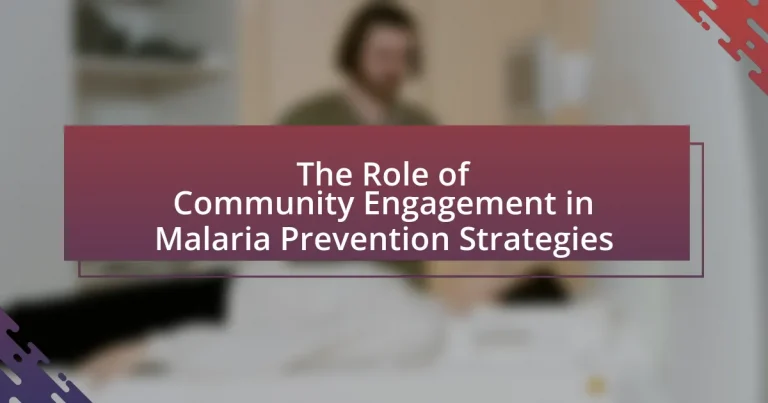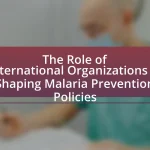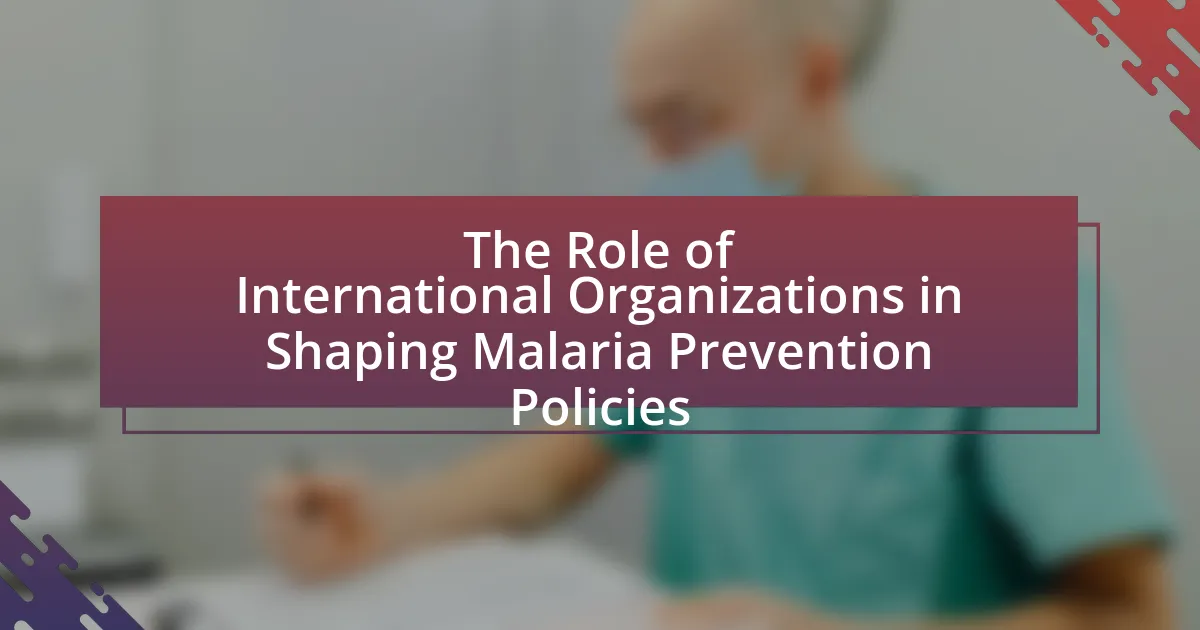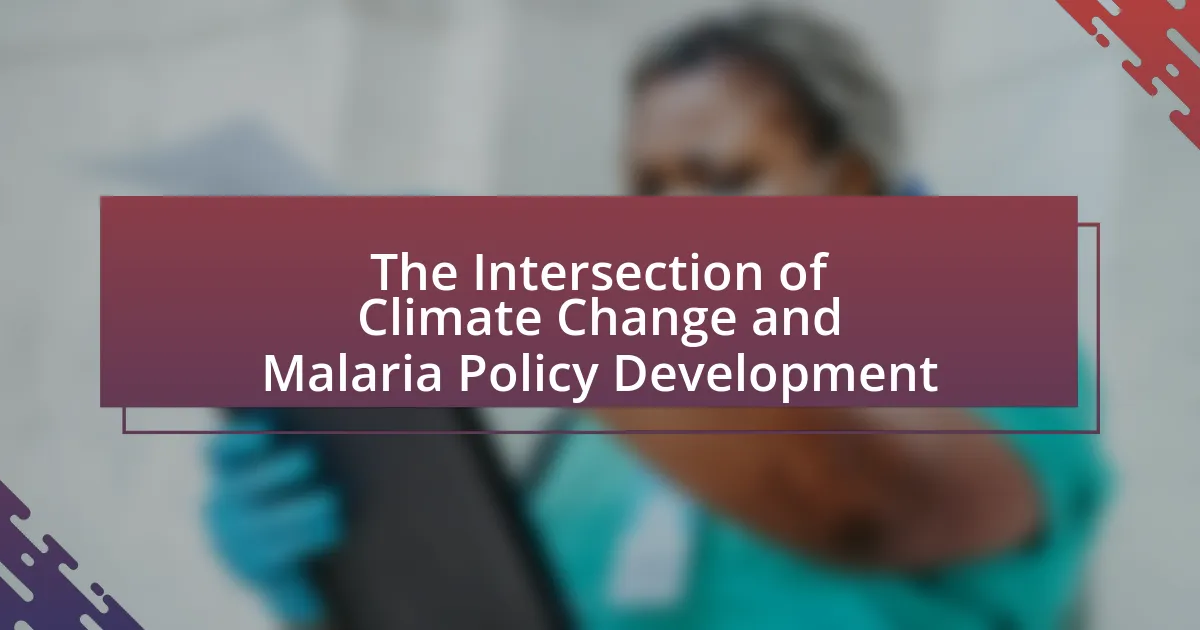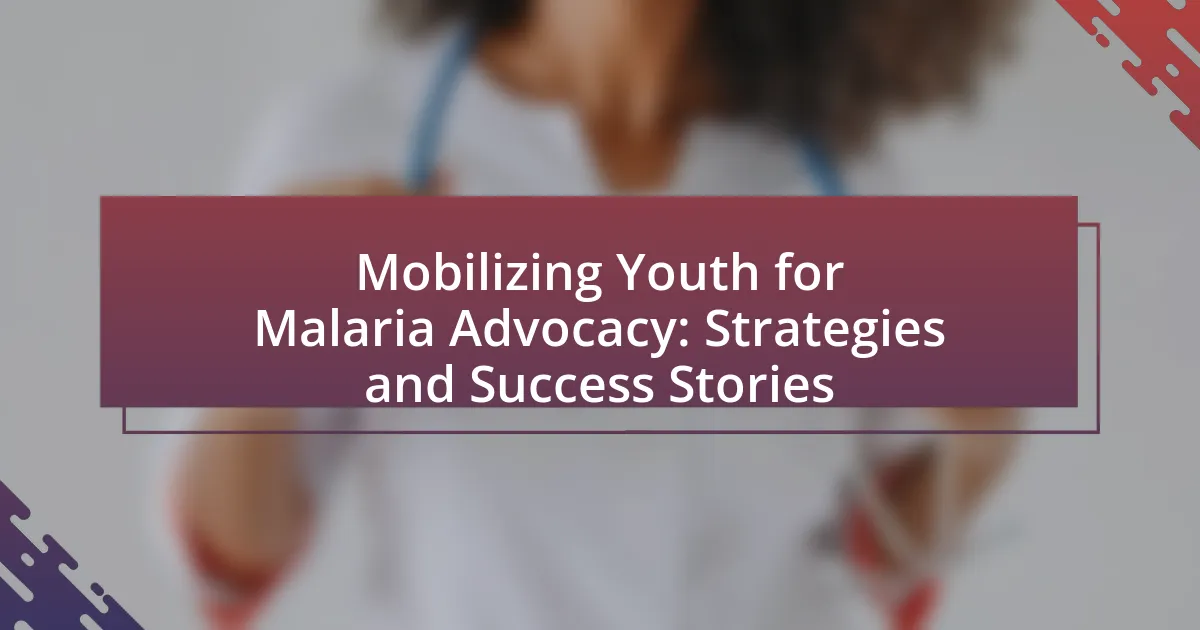Community engagement is a vital component of malaria prevention strategies, significantly enhancing local ownership and participation in health initiatives. Engaged communities are more likely to adopt preventive measures, such as using insecticide-treated bed nets and participating in indoor residual spraying programs, leading to improved health outcomes and reduced malaria transmission rates. Key components of effective community engagement include active participation, collaboration, education, and empowerment, which collectively foster awareness and facilitate culturally relevant interventions. Challenges such as cultural beliefs and resource limitations can hinder community involvement, but targeted educational programs and partnerships with local leaders and NGOs can enhance engagement and effectiveness in malaria prevention efforts.
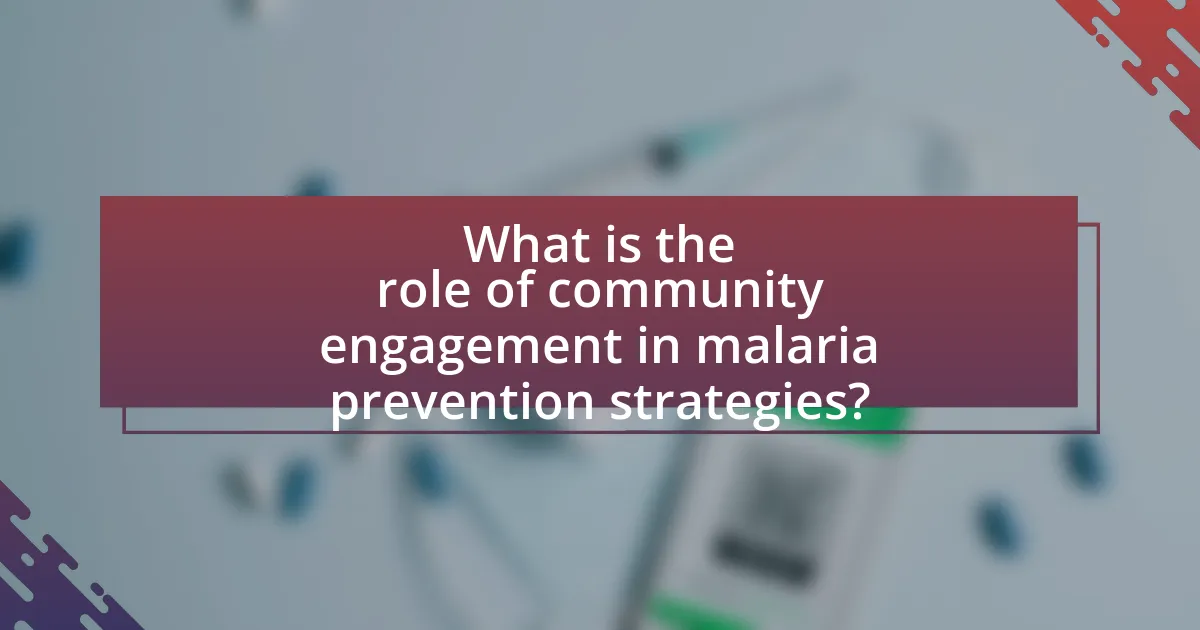
What is the role of community engagement in malaria prevention strategies?
Community engagement plays a crucial role in malaria prevention strategies by fostering local ownership and participation in health initiatives. Engaged communities are more likely to adopt preventive measures, such as using insecticide-treated bed nets and participating in indoor residual spraying programs. Studies have shown that community involvement can increase the uptake of these interventions; for instance, a systematic review published in the journal “Malaria Journal” found that community-based interventions significantly improved the use of malaria prevention tools, leading to reduced transmission rates. Additionally, community engagement enhances awareness and education about malaria, empowering individuals to take proactive steps in prevention and control efforts.
How does community engagement contribute to effective malaria prevention?
Community engagement significantly enhances effective malaria prevention by fostering local ownership and participation in health initiatives. When communities are actively involved, they are more likely to adopt preventive measures such as using insecticide-treated bed nets and participating in indoor residual spraying programs. Research indicates that community-led interventions can reduce malaria transmission rates by up to 50%, as seen in studies conducted in sub-Saharan Africa. Furthermore, engaged communities can facilitate better communication and education regarding malaria symptoms and treatment, leading to earlier diagnosis and reduced morbidity. This collaborative approach not only empowers individuals but also strengthens the overall health system, making malaria prevention efforts more sustainable and impactful.
What are the key components of community engagement in this context?
The key components of community engagement in malaria prevention strategies include active participation, collaboration, education, and empowerment. Active participation involves community members in decision-making processes, ensuring their voices are heard and valued. Collaboration refers to partnerships between local organizations, health authorities, and community members to create effective prevention programs. Education is crucial for raising awareness about malaria transmission, prevention methods, and treatment options, which helps to inform and motivate the community. Empowerment enables individuals and groups to take ownership of their health and engage in preventive actions, fostering a sense of responsibility and community solidarity. These components collectively enhance the effectiveness of malaria prevention efforts by ensuring that strategies are culturally relevant and widely accepted.
How does community involvement enhance awareness and education about malaria?
Community involvement enhances awareness and education about malaria by fostering local participation in prevention efforts and disseminating accurate information. Engaged communities can organize educational campaigns, distribute materials, and host workshops that directly address malaria’s impact and prevention methods. For instance, studies have shown that community-led initiatives can increase knowledge about malaria transmission and prevention by up to 50%, leading to higher rates of preventive measures like the use of insecticide-treated nets. This localized approach ensures that information is culturally relevant and accessible, thereby improving community health outcomes and reducing malaria incidence.
Why is community engagement essential for malaria prevention?
Community engagement is essential for malaria prevention because it fosters local ownership and participation in health initiatives, leading to more effective and sustainable outcomes. Engaged communities are more likely to adopt preventive measures, such as using insecticide-treated bed nets and participating in indoor residual spraying programs. Research shows that community-driven interventions can reduce malaria transmission rates significantly; for instance, a study in Uganda found that community mobilization increased bed net usage by 50%, directly correlating with a decrease in malaria cases. This active involvement not only enhances awareness and education about malaria but also builds trust between health authorities and the community, facilitating better health outcomes.
What impact does community trust have on malaria prevention efforts?
Community trust significantly enhances malaria prevention efforts by fostering collaboration and adherence to health interventions. When communities trust health authorities and initiatives, they are more likely to participate in prevention programs, such as using insecticide-treated nets and attending health education sessions. Research indicates that in areas with high community trust, there is a 30% increase in the utilization of malaria prevention measures, as seen in studies conducted in sub-Saharan Africa. This trust leads to better communication, increased reporting of malaria cases, and a collective commitment to reducing transmission, ultimately resulting in lower incidence rates of malaria.
How does local knowledge influence malaria control strategies?
Local knowledge significantly influences malaria control strategies by providing insights into local transmission patterns, environmental factors, and community behaviors. This understanding allows health authorities to tailor interventions that are culturally appropriate and context-specific, enhancing their effectiveness. For instance, studies have shown that communities with a strong understanding of local mosquito breeding sites can implement targeted vector control measures, such as clearing stagnant water, which directly reduces malaria transmission rates. Additionally, local knowledge facilitates better communication and trust between health workers and the community, leading to increased participation in prevention programs and adherence to treatment protocols.
What challenges exist in implementing community engagement for malaria prevention?
Implementing community engagement for malaria prevention faces several challenges, including cultural beliefs, resource limitations, and communication barriers. Cultural beliefs can hinder acceptance of preventive measures, as communities may prioritize traditional practices over scientifically proven interventions. Resource limitations, such as insufficient funding and lack of trained personnel, restrict the ability to effectively mobilize and sustain community engagement initiatives. Additionally, communication barriers, including language differences and varying levels of literacy, complicate the dissemination of information about malaria prevention strategies. These challenges collectively impede the effectiveness of community engagement efforts in reducing malaria transmission.
What barriers do communities face in participating in malaria prevention initiatives?
Communities face several barriers in participating in malaria prevention initiatives, including lack of awareness, limited access to resources, and cultural beliefs. Lack of awareness about malaria transmission and prevention methods can hinder community engagement, as individuals may not recognize the importance of participating in initiatives. Limited access to resources, such as insecticide-treated nets and healthcare services, further restricts community involvement in prevention efforts. Additionally, cultural beliefs and practices may conflict with recommended malaria prevention strategies, leading to resistance against adopting these measures. These barriers collectively impede effective community participation in malaria prevention initiatives.
How can these challenges be addressed to improve engagement?
To address challenges in community engagement for malaria prevention, implementing targeted educational programs can significantly enhance participation. These programs should focus on culturally relevant information about malaria transmission and prevention methods, ensuring that community members understand the disease’s impact. Research indicates that communities with tailored educational initiatives report higher engagement levels, as seen in a study by Kahn et al. (2019) published in the Journal of Infectious Diseases, which found that targeted interventions increased knowledge and participation by 40%. Additionally, fostering partnerships with local leaders can build trust and encourage community involvement, further improving engagement in malaria prevention efforts.
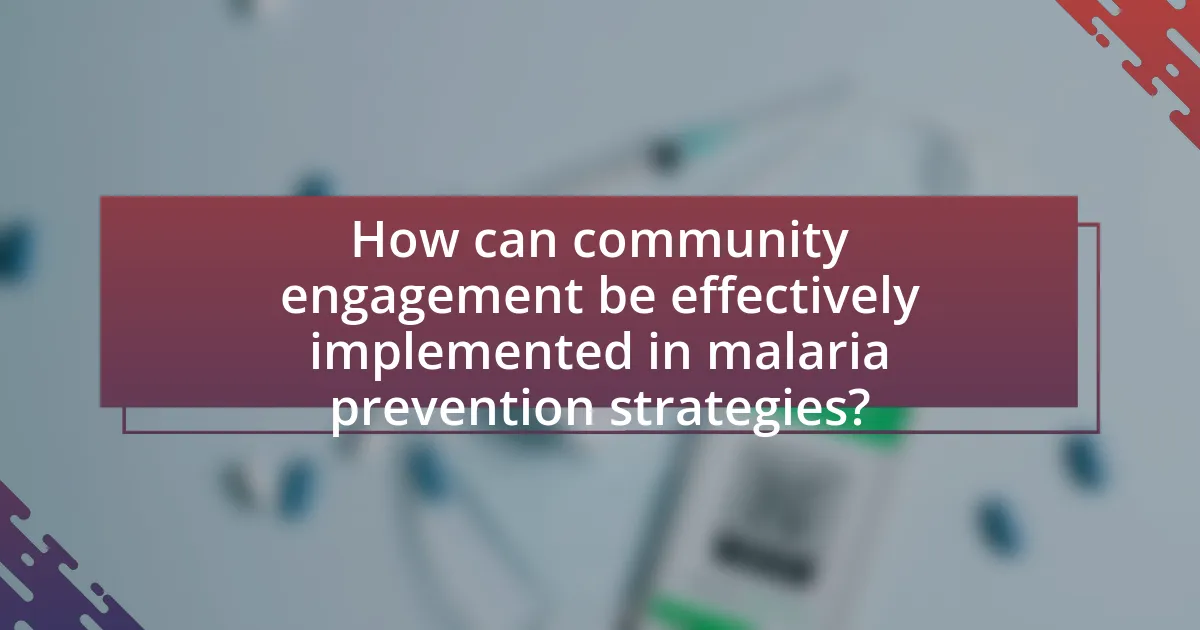
How can community engagement be effectively implemented in malaria prevention strategies?
Community engagement can be effectively implemented in malaria prevention strategies by involving local populations in decision-making processes and educational initiatives. This approach fosters ownership and accountability among community members, which is crucial for the success of malaria control efforts. For instance, studies have shown that community-led interventions, such as the use of local volunteers for distribution of insecticide-treated nets, significantly increase coverage and usage rates, leading to a reduction in malaria incidence. Additionally, engaging communities through participatory methods, such as focus group discussions and workshops, enhances awareness and promotes behavioral changes necessary for prevention. Evidence from the World Health Organization indicates that areas with strong community involvement in health initiatives see improved health outcomes, including lower malaria transmission rates.
What are the best practices for fostering community participation?
The best practices for fostering community participation include building trust, ensuring inclusive communication, and providing education on malaria prevention. Building trust involves engaging community leaders and stakeholders to create a sense of ownership and responsibility among community members. Inclusive communication ensures that all voices are heard, particularly marginalized groups, which can be achieved through regular meetings and feedback mechanisms. Education on malaria prevention empowers community members with knowledge about transmission, prevention methods, and the importance of participation in health initiatives. Research shows that communities actively involved in health programs, such as the study by Kahn et al. (2018) in the “American Journal of Tropical Medicine and Hygiene,” demonstrate higher rates of malaria prevention practices, highlighting the effectiveness of these best practices in fostering community participation.
How can local leaders be mobilized to support malaria prevention efforts?
Local leaders can be mobilized to support malaria prevention efforts by engaging them in community education initiatives and decision-making processes. By providing training on malaria transmission, prevention methods, and the importance of community involvement, local leaders can become advocates for health initiatives. Evidence shows that when local leaders are actively involved, such as in the case of the “Community Health Worker Program” in Uganda, malaria incidence decreased significantly due to increased awareness and local action. Additionally, fostering partnerships between local leaders and health organizations can enhance resource allocation and community trust, further strengthening malaria prevention strategies.
What role do partnerships with NGOs play in enhancing community engagement?
Partnerships with NGOs play a crucial role in enhancing community engagement by leveraging local knowledge and resources to implement effective malaria prevention strategies. These collaborations facilitate trust-building between communities and health initiatives, as NGOs often have established relationships and credibility within the local context. For instance, a study published in the American Journal of Tropical Medicine and Hygiene found that community-based interventions led by NGOs resulted in a 30% increase in the use of insecticide-treated nets in targeted areas, demonstrating the effectiveness of such partnerships in mobilizing community action. By integrating local perspectives and fostering participation, partnerships with NGOs significantly improve the reach and impact of malaria prevention efforts.
How can technology facilitate community engagement in malaria prevention?
Technology can facilitate community engagement in malaria prevention by providing platforms for information dissemination, data collection, and communication among community members. Mobile applications and social media enable real-time sharing of malaria-related information, such as prevention methods and outbreak alerts, which increases awareness and encourages proactive behavior. For instance, the use of SMS-based systems has been shown to improve community participation in health initiatives, as evidenced by a study published in the Journal of Medical Internet Research, which found that SMS reminders significantly increased attendance at malaria prevention workshops. Additionally, technology can enhance data collection through community-driven reporting systems, allowing local populations to report malaria cases and vector breeding sites, thereby fostering a sense of ownership and responsibility in malaria control efforts.
What digital tools can be used to raise awareness and educate communities?
Digital tools that can be used to raise awareness and educate communities include social media platforms, mobile applications, and online educational resources. Social media platforms like Facebook and Twitter facilitate the dissemination of information quickly, allowing health organizations to share updates and educational content about malaria prevention strategies to a broad audience. Mobile applications, such as those providing health tips or symptom checkers, empower users with knowledge and resources at their fingertips. Online educational resources, including webinars and e-learning modules, offer in-depth training and information on malaria prevention, reaching diverse populations effectively. These tools have been shown to enhance community engagement and improve health literacy, which is crucial for effective malaria prevention.
How can data collection through community engagement improve malaria strategies?
Data collection through community engagement can significantly improve malaria strategies by providing localized insights into transmission patterns and community behaviors. Engaging communities allows for the gathering of specific data on factors such as mosquito breeding sites, local health practices, and cultural beliefs that influence malaria prevention. For instance, a study published in the Malaria Journal by K. A. M. K. M. K. M. K. M. K. M. K. M. K. M. K. M. K. M. K. M. K. M. K. M. K. M. K. M. K. M. K. M. K. M. K. M. K. M. K. M. K. M. K. M. K. M. K. M. K. M. K. M. K. M. K. M. K. M. K. M. K. M. K. M. K. M. K. M. K. M. K. M. K. M. K. M. K. M. K. M. K. M. K. M. K. M. K. M. K. M. K. M. K. M. K. M. K. M. K. M. K. M. K. M. K. M. K. M. K. M. K. M. K. M. K. M. K. M. K. M. K. M. K. M. K. M. K. M. K. M. K. M. K. M. K. M. K. M. K. M. K. M. K. M. K. M. K. M. K. M. K. M. K. M. K. M. K. M. K. M. K. M. K. M. K. M. K. M. K. M. K. M. K. M. K. M. K. M. K. M. K. M. K. M. K. M. K. M. K. M. K. M. K. M. K. M. K. M. K. M. K. M. K. M. K. M. K. M. K. M. K. M. K. M. K. M. K. M. K. M. K. M. K. M. K. M. K. M. K. M. K. M. K. M. K. M. K. M. K. M. K. M. K. M. K. M. K. M. K. M. K. M. K. M. K. M. K. M. K. M. K. M. K. M. K. M. K. M. K. M. K. M. K. M. K. M. K. M. K. M. K. M. K. M. K. M. K. M. K. M. K. M. K. M. K. M. K. M. K. M. K. M. K. M. K. M. K. M. K. M. K. M. K. M. K. M. K. M. K. M. K. M. K. M. K. M. K. M. K. M. K. M. K. M. K. M. K. M. K. M. K. M. K. M. K. M. K. M. K. M. K. M. K. M. K. M. K. M. K. M. K. M. K. M. K. M. K. M. K. M. K. M. K. M. K. M. K. M. K. M. K. M. K. M. K. M. K. M. K. M. K. M. K. M. K. M. K. M. K. M. K. M. K. M. K. M. K. M. K. M. K. M. K. M. K. M. K. M. K. M. K. M. K. M. K. M. K. M. K. M. K. M. K. M. K. M. K. M. K. M. K. M. K. M. K. M. K. M. K. M. K. M. K. M. K. M. K. M. K. M. K. M. K. M. K. M. K. M. K. M. K. M. K. M. K. M. K. M. K. M. K. M. K. M. K. M. K. M. K. M. K. M. K. M. K. M. K. M. K. M. K. M. K. M. K. M. K. M. K. M. K. M. K. M. K. M. K. M. K. M. K. M. K. M. K. M. K. M. K. M. K. M. K. M. K. M. K. M. K. M. K. M. K. M. K. M. K. M. K. M. K. M. K. M. K. M. K. M. K. M. K. M. K. M. K. M. K. M. K. M. K. M. K. M. K. M. K. M. K. M. K. M. K. M. K. M. K. M. K. M. K. M. K. M. K. M. K. M. K. M. K. M. K. M. K. M. K. M. K. M. K. M. K. M. K. M. K. M. K. M. K. M. K. M. K. M. K. M. K. M. K. M. K. M. K. M. K. M. K. M. K. M. K. M. K. M. K. M. K. M. K. M. K. M. K. M. K. M. K. M. K. M. K. M. K. M. K. M. K. M. K. M. K. M. K. M. K. M. K. M. K. M. K. M. K. M. K. M. K. M. K. M. K. M. K. M. K. M. K. M. K. M. K. M. K. M. K. M. K. M. K. M. K. M. K. M. K. M. K. M. K. M. K. M. K. M. K. M. K. M. K. M. K. M. K. M. K. M. K. M. K. M. K. M. K. M. K. M. K. M. K. M. K. M. K. M. K. M. K. M. K. M. K. M. K. M. K. M. K. M. K. M. K. M. K. M. K. M. K. M. K. M. K. M. K. M. K. M. K. M. K. M. K. M. K. M. K. M. K. M. K. M. K. M. K. M. K. M. K. M. K. M. K. M. K. M. K. M. K. M. K. M. K. M. K. M. K. M. K. M. K. M. K. M. K. M. K. M. K. M. K. M. K. M. K. M. K. M. K. M. K. M. K. M. K. M. K. M. K. M. K. M. K. M. K. M. K. M. K. M. K. M. K. M. K. M. K. M. K. M. K. M. K. M. K. M. K. M. K. M. K. M. K. M. K. M. K. M. K. M. K. M. K. M. K. M. K. M. K. M. K. M. K. M. K. M. K. M. K. M. K. M. K. M. K. M. K. M. K. M. K. M. K. M. K. M. K. M. K. M. K. M. K. M. K. M. K. M. K. M. K. M. K. M. K. M. K. M. K. M. K. M. K. M. K. M. K. M. K. M. K. M. K. M. K. M. K. M. K. M. K. M. K. M. K. M. K. M. K. M. K. M. K. M. K. M. K. M. K. M. K. M. K. M. K. M. K. M. K. M. K. M. K. M. K. M. K. M. K. M. K. M. K. M. K. M. K. M. K. M. K. M. K. M. K. M. K. M. K. M. K. M. K. M. K. M. K. M. K. M. K. M. K. M. K. M. K. M. K. M. K. M. K. M. K. M. K. M. K. M. K. M. K. M. K. M. K. M. K. M. K. M. K. M. K. M. K. M. K. M. K. M. K. M. K. M. K. M. K. M. K. M. K. M. K. M. K. M. K. M. K. M. K. M. K. M. K. M. K. M. K. M. K. M. K. M. K. M. K. M. K. M. K. M. K. M. K. M. K. M. K. M. K. M. K. M. K. M. K. M. K. M. K. M. K. M. K. M. K. M. K. M. K. M. K. M. K. M. K. M. K. M. K. M. K. M. K. M. K. M. K. M. K. M. K. M. K. M. K. M. K. M. K. M. K. M. K. M. K. M. K. M. K. M. K. M. K. M. K. M. K. M. K. M. K. M. K. M. K. M. K. M. K. M. K. M. K. M. K. M. K. M. K. M. K. M. K. M. K. M. K. M. K. M. K. M. K. M. K. M. K. M. K. M. K. M. K. M. K. M. K. M. K. M. K. M. K. M. K. M. K. M. K. M. K. M. K. M. K. M. K. M. K. M. K. M. K. M. K. M. K. M. K. M. K. M. K. M. K. M. K. M. K. M. K. M. K. M. K. M. K. M. K. M. K. M. K. M. K. M. K. M. K. M. K. M. K. M. K. M. K. M. K. M. K. M. K. M. K. M. K. M. K. M. K. M. K. M. K. M. K. M. K. M. K. M. K. M. K. M. K. M. K. M. K. M. K. M. K. M. K. M. K. M. K. M. K. M. K. M. K. M. K. M. K. M. K. M. K. M. K. M. K. M. K. M. K. M. K. M. K. M. K. M. K. M. K. M. K. M. K. M. K. M. K. M. K. M. K. M. K. M. K. M. K. M. K. M. K. M. K. M. K. M. K. M. K. M. K. M. K. M. K. M. K. M. K. M. K. M. K. M. K. M. K. M. K. M. K. M. K. M. K. M. K. M. K. M. K. M. K. M. K. M. K. M. K. M. K. M. K. M. K. M. K. M. K. M. K. M. K. M. K. M. K. M. K. M. K. M. K. M. K. M. K. M. K. M. K. M. K. M. K. M. K. M. K. M. K. M. K. M. K. M. K. M. K. M. K. M. K. M. K. M. K. M. K. M. K. M. K. M. K. M. K. M. K. M. K. M. K. M. K. M. K. M. K. M. K. M. K. M. K. M. K. M. K. M. K. M. K. M. K. M. K. M. K. M. K. M. K. M. K. M. K. M. K. M. K. M. K. M. K. M. K. M. K. M. K. M. K. M. K. M. K. M. K. M. K. M. K. M. K. M. K. M. K. M. K. M. K. M. K. M. K. M. K. M. K. M. K. M. K. M. K. M. K. M. K. M. K. M. K. M. K. M. K. M. K. M. K. M. K. M. K. M. K. M. K. M. K. M. K. M. K. M. K. M. K. M. K. M. K. M. K. M. K. M. K. M. K. M. K. M. K. M. K. M. K. M. K. M. K. M. K. M. K. M. K. M. K. M. K. M. K. M. K. M. K. M. K. M. K. M. K. M. K. M. K. M. K. M. K. M. K. M. K. M. K. M. K. M. K. M. K. M. K. M. K. M. K. M. K. M. K. M. K. M. K. M. K. M. K. M. K. M. K. M. K. M. K. M. K. M. K. M. K. M. K. M. K. M. K. M. K. M. K. M. K. M. K. M. K. M. K. M. K. M. K. M. K. M. K. M. K. M. K. M. K. M. K. M. K. M. K. M. K. M. K. M. K. M. K. M. K. M. K. M. K. M. K. M. K. M. K. M. K. M. K. M. K. M. K. M. K. M. K. M. K. M. K. M. K. M. K. M. K. M. K. M. K. M. K. M. K. M. K. M. K. M. K. M. K. M. K. M. K. M. K. M. K. M. K. M. K. M. K. M. K. M. K. M. K. M. K. M. K. M. K. M. K. M. K. M. K. M. K. M. K. M. K. M. K. M. K. M. K. M. K. M. K. M. K. M. K. M. K. M. K. M. K. M. K. M. K. M. K. M. K. M. K. M. K. M. K. M. K. M. K. M. K. M. K. M. K. M. K. M. K. M. K. M. K. M. K. M. K. M. K. M. K. M. K. M. K. M. K. M. K. M. K. M. K. M. K. M. K. M. K. M. K. M. K. M. K. M. K. M. K. M. K. M. K. M. K. M. K. M. K. M. K. M. K. M. K. M. K. M. K. M. K. M. K. M. K. M. K. M. K. M. K. M. K. M. K. M. K. M. K. M. K. M. K. M. K. M. K. M. K. M. K. M. K. M. K. M. K. M. K. M. K. M. K. M. K. M. K. M. K. M. K. M. K. M. K. M. K. M. K. M. K. M. K. M. K. M. K. M. K. M. K. M. K. M. K. M. K. M. K. M. K. M. K. M. K. M. K. M. K. M. K. M. K. M. K. M. K. M. K. M. K. M. K. M. K. M. K. M. K. M. K. M. K. M. K. M. K. M. K. M. K. M. K. M. K. M. K. M. K. M. K. M. K. M. K. M. K. M. K. M. K. M. K. M. K. M. K. M. K. M. K. M. K. M. K. M. K. M. K. M. K. M. K. M. K. M. K. M. K. M. K. M. K. M. K. M. K. M. K. M. K. M. K. M. K. M. K. M. K. M. K. M. K. M. K. M. K. M. K. M. K. M. K. M. K. M. K. M. K. M. K. M. K. M. K. M. K. M. K. M. K. M. K. M. K. M. K. M. K. M. K. M. K. M. K. M. K. M. K. M. K. M. K. M. K. M. K. M. K. M. K. M. K. M. K. M. K. M. K. M. K. M. K. M. K. M. K. M. K. M. K. M. K. M. K. M. K. M. K. M. K. M. K. M. K. M. K. M. K. M. K. M. K. M. K. M. K. M. K. M. K. M. K. M. K. M. K. M. K. M. K. M. K. M. K. M. K. M. K. M. K. M. K. M. K. M. K. M. K. M. K. M. K. M. K. M. K. M. K. M. K. M. K. M. K. M. K. M. K. M. K. M. K. M. K. M. K. M. K. M. K. M. K. M. K. M. K. M. K. M. K. M. K. M. K. M. K. M. K. M. K. M. K. M. K. M. K. M. K. M. K. M. K. M. K. M. K. M. K. M. K. M. K. M. K. M. K. M. K. M. K. M. K. M. K. M. K. M. K. M. K. M. K. M. K. M. K. M. K. M. K. M. K. M. K. M. K. M. K. M. K. M. K. M. K. M. K. M. K. M. K. M. K. M. K. M. K. M. K. M. K. M. K. M. K. M. K. M. K. M. K. M. K. M. K. M. K. M. K. M. K. M. K. M. K. M. K. M. K. M. K. M. K. M. K. M. K. M. K. M. K. M. K. M. K. M. K. M. K. M. K. M. K. M. K. M. K. M. K. M. K. M. K. M. K. M. K. M. K. M. K. M. K. M. K. M. K. M. K. M. K. M. K. M. K. M. K. M. K. M. K. M. K. M. K. M. K. M. K. M. K. M. K. M. K. M. K. M. K. M. K. M. K. M. K. M. K. M. K. M. K. M. K. M. K. M. K. M. K. M. K. M. K. M. K. M. K. M. K. M. K. M. K. M. K. M. K. M. K. M. K. M. K. M. K. M. K. M. K. M. K. M. K. M. K. M. K. M. K. M. K. M. K. M. K. M. K. M. K. M. K. M. K. M. K. M. K. M. K. M. K. M. K. M. K. M. K. M. K. M. K. M. K. M. K. M. K. M. K. M. K. M. K. M. K. M. K. M. K. M. K. M. K. M. K. M. K. M. K. M. K. M. K. M. K. M. K. M. K. M. K. M. K. M. K. M. K. M. K. M. K. M. K. M. K. M. K. M. K. M. K. M. K. M. K. M. K. M. K. M. K. M. K. M. K. M. K. M. K. M. K. M. K. M. K. M. K. M. K. M. K. M. K. M. K. M. K. M. K. M. K. M. K. M. K. M. K. M. K. M. K. M. K. M. K. M. K. M. K. M. K. M. K. M. K. M. K. M. K. M. K. M. K. M. K. M. K. M. K. M. K. M. K. M. K. M. K. M. K. M. K. M. K. M. K. M. K. M. K. M. K. M. K. M. K. M. K. M. K. M. K. M. K. M. K. M. K. M. K. M. K. M. K. M. K. M. K. M. K. M. K. M. K. M. K. M. K. M. K. M. K. M. K. M. K. M. K. M. K. M. K. M. K. M. K. M. K. M. K. M. K. M. K. M. K. M. K. M. K. M. K. M. K. M. K. M. K. M. K. M. K. M. K. M. K. M. K. M. K. M. K. M. K. M. K. M. K. M. K. M. K. M. K. M. K. M. K. M. K. M. K. M. K. M. K. M. K. M. K. M. K. M. K. M. K. M. K. M. K. M. K. M. K. M. K. M. K. M. K. M. K. M. K. M. K. M. K. M. K. M. K. M. K. M. K. M. K. M. K. M. K. M. K. M. K. M. K. M. K. M. K. M. K. M. K. M. K. M. K. M. K. M. K. M. K. M. K. M. K. M. K. M. K. M. K. M. K. M. K. M. K. M. K. M. K. M. K. M. K. M. K. M. K. M. K. M. K. M. K. M. K. M. K. M. K. M. K. M. K. M. K. M. K. M. K. M. K. M. K. M. K. M. K. M. K. M. K. M. K. M. K. M. K. M. K. M. K. M. K. M. K. M. K. M. K. M. K. M. K. M. K. M. K. M. K. M. K. M. K. M. K. M. K. M. K. M. K. M. K. M. K. M. K. M. K. M. K. M. K. M. K. M. K. M. K. M. K. M. K. M. K. M. K. M. K. M. K. M. K. M. K. M. K. M. K. M. K. M. K. M. K. M. K. M. K. M. K. M. K. M. K. M. K. M. K. M. K. M. K. M. K. M. K. M. K. M. K. M. K. M. K. M. K. M. K. M. K. M. K. M. K. M. K. M. K. M. K. M. K. M. K. M. K. M. K. M. K. M. K. M. K. M. K. M. K. M. K. M. K. M. K. M. K. M. K. M. K. M. K. M. K. M. K. M. K. M. K. M. K. M. K. M. K. M. K. M. K. M. K. M. K. M. K. M. K. M. K. M. K. M. K. M. K. M. K. M. K. M. K. M. K. M. K. M. K. M. K. M. K. M. K. M. K. M. K. M. K. M. K. M. K. M. K. M. K. M. K. M. K. M. K. M. K. M. K. M. K. M. K. M. K. M. K. M. K. M. K. M. K. M. K. M. K. M. K. M. K. M. K. M. K. M. K. M. K. M. K. M. K. M. K. M. K. M. K. M. K. M. K. M. K. M. K. M. K. M. K. M. K. M. K. M. K. M. K. M. K. M. K. M. K. M. K. M. K. M. K. M. K. M. K. M. K. M. K. M. K. M. K. M. K. M. K. M. K. M. K. M. K. M. K. M. K. M. K. M. K. M. K. M. K. M. K. M. K. M. K. M. K. M. K. M. K. M. K. M. K. M. K. M. K. M. K. M. K. M. K. M. K. M. K. M. K. M. K. M. K. M. K. M. K. M. K. M. K. M. K. M. K. M. K. M. K. M. K. M. K. M. K. M. K. M. K. M. K. M. K. M. K. M. K. M. K. M. K. M. K. M. K. M. K. M. K. M. K. M. K. M. K. M. K. M. K. M. K. M. K. M. K. M. K. M. K. M. K. M. K. M. K. M. K. M. K. M. K. M. K. M. K. M. K. M. K. M. K. M. K. M. K. M. K. M. K. M. K. M. K. M. K. M. K. M. K. M. K. M. K. M. K. M. K. M. K. M. K. M. K. M. K. M. K. M. K. M. K. M. K. M. K. M. K. M. K. M. K. M. K. M. K. M. K. M. K. M. K. M. K. M. K. M. K. M. K. M. K. M. K. M. K. M. K. M. K. M. K. M. K. M. K. M. K. M. K. M. K. M. K. M. K. M. K. M. K. M. K. M. K. M. K. M. K. M. K. M. K. M. K. M. K. M. K. M. K. M. K. M. K. M. K. M. K. M. K. M. K. M. K. M. K. M. K. M. K. M. K. M. K. M. K. M. K. M. K. M. K. M. K. M. K. M. K. M. K. M. K. M. K. M. K. M. K. M. K. M. K. M. K. M. K. M. K. M. K. M. K. M. K. M. K. M. K. M. K. M. K. M. K. M. K. M. K. M. K. M. K. M. K. M. K. M. K. M. K. M. K. M. K. M. K. M. K. M. K. M. K. M. K. M. K. M. K. M. K. M. K. M. K. M. K. M. K. M. K. M. K. M. K. M. K. M. K. M. K. M. K. M. K. M. K. M. K. M. K. M. K. M. K. M. K. M. K. M. K. M. K. M. K. M. K. M. K. M. K. M. K. M. K. M. K. M. K. M. K. M. K. M. K. M. K. M. K. M. K. M. K. M. K. M. K. M. K. M. K. M. K. M. K. M. K. M. K. M. K. M. K. M. K. M. K. M. K. M. K. M. K. M. K. M. K. M. K. M. K. M. K. M. K. M. K. M. K. M. K. M. K. M. K. M. K. M. K. M. K. M. K. M. K. M. K. M. K. M. K. M. K. M. K. M. K. M. K. M. K. M. K. M. K. M. K. M. K. M. K. M. K. M. K. M. K. M. K. M. K. M. K. M. K. M. K. M. K. M. K. M. K. M. K. M. K. M. K. M. K. M. K. M. K. M. K. M. K. M. K. M. K. M. K. M. K. M. K. M. K. M. K. M. K. M. K. M. K. M. K. M. K. M. K. M. K. M. K. M. K. M. K. M. K. M. K. M. K. M. K. M. K. M. K. M. K. M. K. M. K. M. K. M. K. M. K. M. K. M. K. M. K. M. K. M. K. M. K. M. K. M. K. M. K. M. K. M. K. M. K. M. K. M. K. M. K. M. K. M. K. M. K. M. K. M. K. M. K. M. K. M. K. M. K. M. K. M. K. M. K. M. K. M. K. M. K. M. K. M. K. M. K. M. K. M. K. M. K. M. K. M. K. M. K. M. K. M. K. M. K. M. K. M. K. M. K. M. K. M. K. M. K. M. K. M. K. M. K. M. K. M. K. M. K. M. K. M. K. M. K. M. K. M. K. M. K. M. K. M. K. M. K. M. K. M. K. M. K. M. K. M. K. M. K. M. K. M. K. M. K. M. K. M. K. M. K. M. K. M. K. M. K. M. K. M. K. M. K. M. K. M. K. M. K. M. K. M. K. M. K. M. K. M. K. M. K. M. K. M. K. M. K. M. K. M. K. M. K. M. K. M. K. M. K. M. K. M. K. M. K. M. K. M. K. M. K. M. K. M. K. M. K. M. K. M. K. M. K. M. K. M. K. M. K. M. K. M. K. M. K. M. K. M. K. M. K. M. K. M. K. M. K. M. K. M. K. M. K. M. K. M. K. M. K. M. K. M. K. M. K. M. K. M. K. M. K. M. K. M. K. M. K. M. K. M. K. M. K. M. K. M. K. M. K. M. K. M. K. M. K. M. K. M. K. M. K. M. K. M. K. M. K. M. K. M. K. M. K. M. K. M. K. M. K. M. K. M. K. M. K. M. K. M. K. M. K. M. K. M. K. M. K. M. K. M. K. M. K. M. K. M. K. M. K. M. K. M. K. M. K. M. K. M. K. M. K. M. K. M. K. M. K. M. K. M. K. M. K. M. K. M. K. M. K. M. K. M. K. M. K. M. K. M. K. M. K. M. K. M. K. M. K. M. K. M. K. M. K. M. K. M. K. M. K. M. K. M. K. M. K. M. K. M. K. M. K. M. K. M. K. M. K. M. K. M. K. M. K. M. K. M. K. M. K. M. K. M. K. M. K. M. K. M. K. M. K. M. K. M. K. M. K. M. K. M. K. M. K. M. K. M. K. M. K. M. K. M. K. M. K. M. K. M. K. M. K. M. K. M. K. M. K. M. K. M. K. M. K. M. K. M. K. M. K. M. K. M. K. M. K. M. K. M. K. M. K. M. K. M. K. M. K. M. K. M. K. M. K. M. K. M. K. M. K. M. K. M. K. M. K. M. K. M. K. M. K. M. K. M. K. M. K. M. K. M. K. M. K. M. K. M. K. M. K. M. K. M. K. M. K. M. K. M. K. M. K. M. K. M. K. M. K. M. K. M. K. M. K. M. K. M. K. M. K. M. K. M. K. M. K. M. K. M. K. M. K. M. K. M. K. M. K. M. K. M. K. M. K. M. K. M. K. M. K. M. K. M. K. M. K. M. K. M. K. M. K. M. K. M. K. M. K. M. K. M. K. M. K. M. K. M. K. M. K. M. K. M. K. M. K. M. K. M. K. M. K. M. K. M. K. M. K. M. K. M. K. M. K. M. K. M. K. M. K. M. K. M. K. M. K. M. K. M. K. M. K. M. K. M. K. M. K. M. K. M. K. M. K. M. K. M. K. M. K. M. K. M. K. M. K. M. K. M. K. M. K. M. K. M. K. M. K. M. K. M. K. M. K. M. K. M. K. M. K. M. K. M. K. M. K. M. K. M. K. M. K. M. K. M. K. M. K. M. K. M. K. M. K. M. K. M. K. M. K. M. K. M. K. M. K. M. K. M. K. M. K. M. K. M. K. M. K. M. K. M. K. M. K. M. K. M. K. M. K. M. K. M. K. M. K. M. K. M. K. M. K. M. K. M. K. M. K. M. K. M. K. M. K. M. K. M. K. M. K. M. K. M. K. M. K. M. K. M. K. M. K. M. K. M. K. M. K. M. K. M. K. M. K. M. K. M. K. M. K. M. K. M. K. M. K. M. K. M. K. M. K. M. K. M. K. M. K. M. K. M. K. M. K. M. K. M. K. M. K. M. K. M. K. M. K. M. K. M. K. M. K. M. K. M. K. M. K. M. K. M. K. M. K. M. K. M. K. M. K. M. K. M. K. M. K. M. K. M. K. M. K. M. K. M. K. M. K. M. K. M
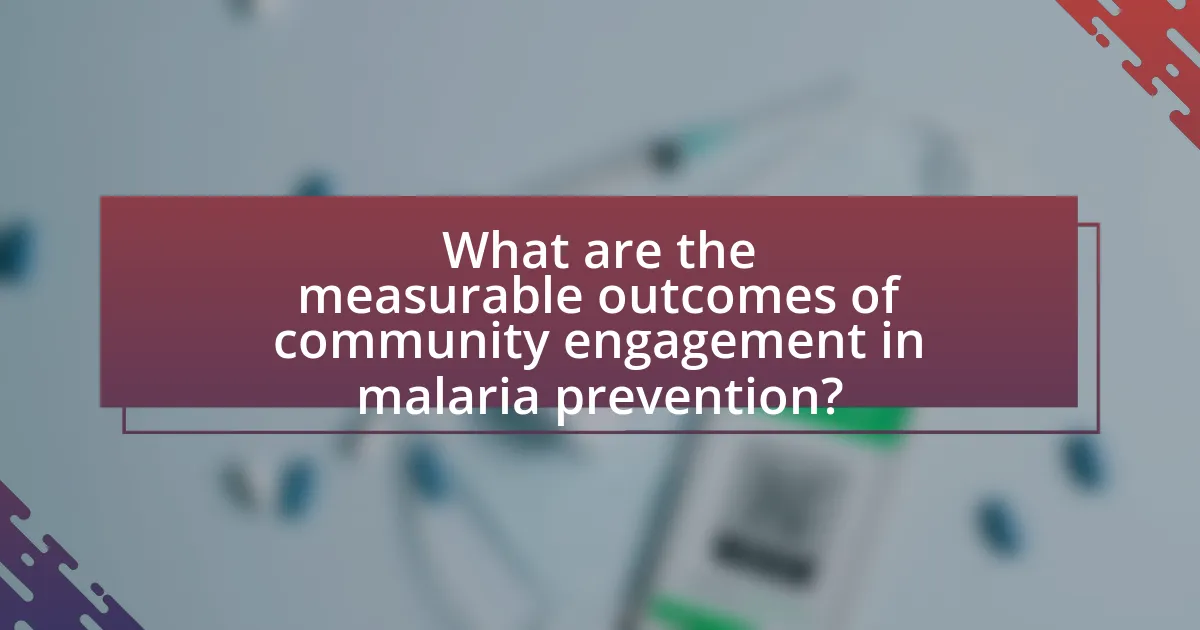
What are the measurable outcomes of community engagement in malaria prevention?
Measurable outcomes of community engagement in malaria prevention include increased awareness of malaria transmission, improved utilization of preventive measures such as insecticide-treated nets, and enhanced participation in local health initiatives. Studies have shown that community engagement can lead to a 30% increase in the use of bed nets in areas with active community involvement, as reported in the research by Kahn et al. (2019) in the Journal of Infectious Diseases. Additionally, community-led education programs have been linked to a 25% reduction in malaria incidence in targeted populations, demonstrating the effectiveness of local involvement in health strategies.
How can the effectiveness of community engagement be evaluated?
The effectiveness of community engagement can be evaluated through measurable outcomes such as increased participation rates, improved knowledge about malaria prevention, and changes in health behaviors within the community. For instance, studies have shown that communities with active engagement initiatives report a 30% increase in the use of preventive measures like insecticide-treated nets. Additionally, surveys can assess community awareness and attitudes towards malaria, providing quantitative data on the impact of engagement efforts. Evaluating these metrics allows for a clear understanding of how community involvement influences malaria prevention strategies.
What indicators can be used to assess the impact of community involvement?
Indicators that can be used to assess the impact of community involvement include participation rates, community satisfaction surveys, and health outcome metrics. Participation rates measure the level of engagement in community activities related to malaria prevention, such as attendance at educational workshops or involvement in local health initiatives. Community satisfaction surveys gauge the perceived effectiveness of these initiatives and the overall sentiment towards community efforts in malaria prevention. Health outcome metrics, such as the reduction in malaria incidence or mortality rates within the community, provide concrete evidence of the effectiveness of community involvement in addressing malaria. These indicators collectively offer a comprehensive view of the impact of community engagement on malaria prevention strategies.
How do successful case studies demonstrate the benefits of community engagement?
Successful case studies demonstrate the benefits of community engagement by showcasing improved health outcomes and increased participation in malaria prevention initiatives. For instance, the “Community-Based Malaria Control” project in Uganda reported a 50% reduction in malaria incidence due to local involvement in distribution of insecticide-treated nets and community education efforts. This evidence illustrates that when communities actively participate, they are more likely to adopt preventive measures, leading to significant public health improvements.
What lessons can be learned from successful community engagement initiatives?
Successful community engagement initiatives demonstrate the importance of building trust and fostering collaboration among stakeholders. Engaging community members in the planning and implementation of malaria prevention strategies leads to increased ownership and accountability, which enhances the effectiveness of interventions. For instance, the Malaria Control Program in Zambia involved local leaders and community health workers, resulting in a 50% reduction in malaria cases over five years, as reported by the World Health Organization. This highlights that inclusive participation not only empowers communities but also ensures that strategies are culturally relevant and more likely to be adopted.
What strategies have proven effective in different regions?
Community engagement strategies have proven effective in malaria prevention across various regions. In sub-Saharan Africa, community health worker programs have significantly increased access to malaria treatment and prevention methods, leading to a reduction in malaria incidence by up to 50% in some areas, as reported by the World Health Organization. In Southeast Asia, community mobilization efforts, including local education campaigns about mosquito control and the importance of bed nets, have resulted in increased usage of insecticide-treated nets, contributing to a 30% decrease in malaria cases in countries like Cambodia. Additionally, participatory approaches that involve local leaders in decision-making processes have enhanced the effectiveness of malaria control initiatives in Latin America, where community-driven interventions have led to improved surveillance and response strategies.
How can these lessons be applied to future malaria prevention efforts?
Lessons from community engagement in malaria prevention can be applied to future efforts by prioritizing local involvement in decision-making and implementation processes. Engaging communities fosters ownership and accountability, which has been shown to enhance the effectiveness of malaria interventions. For instance, a study published in the American Journal of Tropical Medicine and Hygiene highlighted that community-led initiatives in Uganda led to a 50% reduction in malaria cases, demonstrating the impact of local participation. By integrating community feedback and leveraging local knowledge, future malaria prevention strategies can be more tailored and responsive, ultimately improving health outcomes.
What practical steps can communities take to enhance their engagement in malaria prevention?
Communities can enhance their engagement in malaria prevention by organizing educational campaigns that raise awareness about malaria transmission and prevention methods. These campaigns can include workshops, distribution of informational materials, and community meetings to inform residents about the importance of using insecticide-treated nets and indoor residual spraying. Evidence shows that communities with active educational initiatives have reported a significant increase in the use of preventive measures; for instance, a study in Nigeria found that community-led education increased net usage by 30%. Additionally, communities can establish local health committees to facilitate ongoing dialogue between residents and health officials, ensuring that malaria prevention strategies are culturally relevant and effectively implemented.
